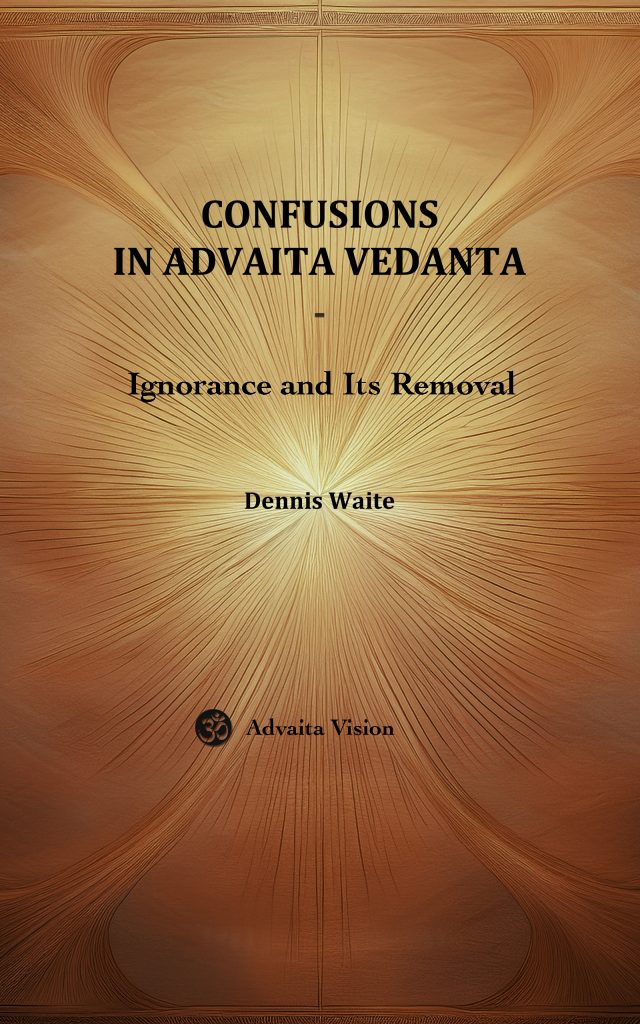
As promised, I have now published Volume 2 of ‘Confusions in Advaita Vedanta’ – ‘Ignorance and Its Removal’ on Kindle.
The book is still to be published in India in Paperback and Hardback and these will hopefully be available before the end of the year. Meanwhile, my Indian publisher – Indica Books – has very kindly agreed for me to publish this in advance on Kindle.
It may be purchased from Amazon US for $9.99 and Amazon UK for £7.60. It is also available at other Amazon stores around the world –Germany, France, Spain, Italy, Netherlands, Japan, Brazil, Canada, Mexico, Australia and India. The prices are similar (converted at appropriate exchange rates)
Purchase from Amazon US……………………Purchase from Amazon UK.
Here is a brief description of the book:
Are you confused about the fundamental concepts of Advaita Vedānta?
Dennis Waite, author of over 12 books on Advaita, presents Volume 2 of his rigorous exploration into the most contentious topics facing spiritual seekers. While the first volume looked specifically at the relative value of knowledge and experience for enlightenment, this essential sequel asks whether ignorance is an actual entity that must be destroyed.
This book is designed for spiritual seekers who are committed to the teaching of Advaita but remain uncertain about the ‘correct’ understanding of the core principles. This work reveals Śaṅkara’s view of the matter and show where other authors diverge, enabling the reader to discern essential teaching from academic complexity.
All of the key, post-Śaṅkara concepts and arguments are addressed, such as mūlāvidyā, avidyāleśa, mithyājñāna. Contrary views such as those of Ramanuja’s ‘Seven Untenables’, are covered, and the attempts by Sri Satchidanandendra to re-establish Śaṅkara’s authentic teaching.
The book then considers exactly what happens, once Self-knowledge has brought about ‘enlightenment’. What happens to the jīva who is now a jñānī, and does the world disappear?
Waite explicitly highlights areas of confusion to enable the reader to understand what is important and what can be safely ignored. The fundamental purpose is to lead seekers to a deep and proper understanding of traditional Advaita Vedānta.
The Contents of the book are as follows:
About the Book 9
Who is this book for? 9
Traditional versus Modern 9
Learning from books 10
Difficulties with this book 11
Specific Topic of this Volume 11
What qualifications/authority? 12
1. Terminology 14
a) Introduction 14
b) Words for ‘Ignorance’ 18
i) Avidyā and ajñāna 19
ii) Adhyāsa 29
iii) Māyā 42
2. The Power of Ignorance 56
a) Āvaraṇa and Vikṣepa 56
b) Non-apprehension and non-existence 58
c) Pratiyogin 58
3. The Existence of Ignorance 61
a) Introduction 61
b) Difference between ‘real’ and ‘existent’ 61
c) Not ‘absence of knowledge’ 62
d) A Positive Entity 63
e) Ended by knowledge 65
f) Ignorance is not objective 66
g) Epistemology versus ontology 68
h) Mind — cause or result? 69
j) ‘Destruction’ of ignorance 71
i) Is avidyā nivṛtti real? 71
ii) ‘Rise of knowledge’ 72
k) Perception and Error 74
i) A brief diversion into Nyāya philosophy 74
ii) Advaita continued! 75
l) Khyāti 76
4. More Terminology 78
a) Mithyā 78
b) Anirvacanīya 79
c) Difference between mithyā and anirvacanīya 81
d) Self-ignorance 81
e) Other terms 82
5. The ‘Key Players’ 84
a) Pre-Śaṅkara 84
b) Sureśvara 85
c) Rāmānuja and ‘The Seven Great Untenables’ 86
i) Locus of ignorance — āśraya anupapatti 86
ii) Obscuration — tirodhāna anupapatti 94
iii) Ontological status — svarūpa anupapatti 95
iv) No pramāṇa — pramāṇa anupapatti 96
v) Right knowledge cannot remove —nivartaka anupapatti 96
vi) Inexplicability — anirvacanīya anupapatti 97
vii) Cessation of avidyā — nivṛtti anupapatti 98
d) Vimuktātman — anirvacanīya khyāti 98
e) Vidyāraṇya 100
f) Sarvajñātman 101
g) Satchidanandendra 103
i) Introduction 103
ii) His objections 106
iii) Existence of ignorance 107
iv) Cause of avidyā 110
v) Beginninglessness 111
vi) Deep-sleep state 112
vii) Re-emergence of avidyā in waking and dream 118
viii) Locus and object of ignorance 119
ix) Result of ignorance 120
x) Removal by knowledge 120
xi) Problems with his understanding 121
xii) Final Remarks 122
6. Related Topics 124
a) Self-knowledge 124
b) Unmanifest creation 124
c) Plurality 125
d) Language 126
7. Some Conclusions 128
a) Who is ignorant? 128
b) Malevolent force 129
c) Removal of ignorance 129
e) Arrival of knowledge 130
f) What and where is ignorance? 131
g) Shell-silver and anubhava 131
h) Summary of key aspects 132
j) A final example 134
8. What happens on enlightenment? 136
a) What happens to the ‘person’ 136
i) The rope-snake metaphor 136
ii) Enlightened Man disembodied 137
iii) Enlightened Man has no ego 140
iv) Enlightened Man has no mind 141
v) Expiration of prārabdha 143
vi) Enlightenment means the end of saṃsāra 144
b) Enlightened Man still sees the world 145
i) Upadeśa Sāhasrī 145
ii) Aṣṭāvakra Gītā 18.72 146
iii) Gauḍapāda Kārikā 2.31 147
iv) Naiṣkarmya Siddhi 4.51 147
v) Brahmasūtra 3.4.50 148
vi) Brahmasūtra 1.1.4 148
vii) Gauḍapāda Kārikā 3.32 149
viii) Bhagavad Gītā 5.18 150
ix) Realizing the truth 150
9. What Happens to the World 152
a) The confusion 152
b) The problems 153
c) The world is Brahman 154
d) Negation of the error 156
e) World has never existed 157
f) It is Self-ignorance that disappears 159
g) World appearance cannot be denied 161
h) Anṛta 165
j) Relevance of Dream metaphor 165
k) Relevance of the Deep-sleep State 167
l) Misconstruing and mis-translation 169
i) Brahmasūtra Bhāṣya 3.2.21 169
ii) Brahmasūtra Bhāṣya 4.1.3 172
iii) Brahmasūtra Bhāṣya 2.1.14 174
iv) Kaṭha Upaniṣad 1.3.14 175
m) Eka-jīva-vāda 176
n) Post-Śaṅkara teachers 176
i) Sureśvara 176
ii) Vidyāraṇya 177
iii) Ramakrishna and Vivekananda 177
iv) Ramana Maharshi 179
v) Nisargadatta 181
10. Summary of the Essential Points 182
Conclusion 184
Glossary 185
Bibliography 211
Index 226

Congratulations Dennis. I am looking forward to getting a copy once it is available in India.
Bimal